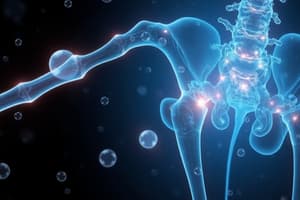Podcast
Questions and Answers
Bisphosphonates are primarily used to treat osteoporosis because they:
Bisphosphonates are primarily used to treat osteoporosis because they:
- Directly increase calcium absorption from the intestines.
- Increase osteoblast activity, promoting bone formation.
- Stimulate the production of vitamin D in the kidneys.
- Prevent the breakdown of bone by inhibiting osteoclast activity. (correct)
Aminobisphosphonates disrupt the mevalonate pathway inside osteoclasts, leading to:
Aminobisphosphonates disrupt the mevalonate pathway inside osteoclasts, leading to:
- Increased osteoblast differentiation.
- Stimulation of vitamin D production.
- Apoptosis of the osteoclast. (correct)
- Enhanced calcium deposition in bone.
Why is it recommended that bisphosphonates be taken on an empty stomach with plain water?
Why is it recommended that bisphosphonates be taken on an empty stomach with plain water?
- To minimize interference with absorption from food and divalent cations. (correct)
- To prevent gastrointestinal side effects.
- To speed up their metabolism by liver enzymes.
- To enhance their binding to bone minerals.
A patient with poor renal function is prescribed medication for osteoporosis. Which class of drugs should be used with caution, if at all?
A patient with poor renal function is prescribed medication for osteoporosis. Which class of drugs should be used with caution, if at all?
Teriparatide, a parathyroid hormone analog, is used to treat osteoporosis because it:
Teriparatide, a parathyroid hormone analog, is used to treat osteoporosis because it:
What is the primary reason estrogen therapy may be considered for osteoporosis prevention in certain women?
What is the primary reason estrogen therapy may be considered for osteoporosis prevention in certain women?
Raloxifene, a selective estrogen receptor modulator (SERM), offers an advantage over estrogen therapy for some women because it:
Raloxifene, a selective estrogen receptor modulator (SERM), offers an advantage over estrogen therapy for some women because it:
How does strontium ranelate work to treat osteoporosis?
How does strontium ranelate work to treat osteoporosis?
Calcitonin is administered to treat osteoporosis. Which of the following is a notable route of administration for calcitonin?
Calcitonin is administered to treat osteoporosis. Which of the following is a notable route of administration for calcitonin?
In children, vitamin D deficiency prior to epiphyseal fusion can lead to:
In children, vitamin D deficiency prior to epiphyseal fusion can lead to:
Which of the following best describes the primary cause of osteomalacia?
Which of the following best describes the primary cause of osteomalacia?
A patient is diagnosed with drug-induced osteomalacia. Which medication is most likely contributing to this condition?
A patient is diagnosed with drug-induced osteomalacia. Which medication is most likely contributing to this condition?
Calcitriol, a form of vitamin D, affects calcium homeostasis by:
Calcitriol, a form of vitamin D, affects calcium homeostasis by:
What is the mechanism by which vitamin D increases serum calcium concentrations?
What is the mechanism by which vitamin D increases serum calcium concentrations?
Why can long-term overadministration of calcitriol lead to toxicity?
Why can long-term overadministration of calcitriol lead to toxicity?
Flashcards
Osteoporosis
Osteoporosis
A disease characterized by low bone mass and microarchitectural deterioration of bone tissue, leading to enhanced bone fragility and a consequent increase in fracture risk.
Bisphosphonates
Bisphosphonates
Agents that prevent the breakdown of bone by inhibiting osteoclast activity.
Alendronate
Alendronate
Prototype aminobisphosphonate drug used to treat osteoporosis.
Aminobisphosphonates
Aminobisphosphonates
Signup and view all the flashcards
Non-aminobisphosphonates
Non-aminobisphosphonates
Signup and view all the flashcards
Indications for Bisphosphonates
Indications for Bisphosphonates
Signup and view all the flashcards
Pharmacokinetics of Bisphosphonates
Pharmacokinetics of Bisphosphonates
Signup and view all the flashcards
Parathyroid Hormone (PTH)
Parathyroid Hormone (PTH)
Signup and view all the flashcards
Teriparatide
Teriparatide
Signup and view all the flashcards
Effects of PTH on Bone
Effects of PTH on Bone
Signup and view all the flashcards
Estrogens
Estrogens
Signup and view all the flashcards
Raloxifene
Raloxifene
Signup and view all the flashcards
Strontium Ranelate
Strontium Ranelate
Signup and view all the flashcards
Calcitonin
Calcitonin
Signup and view all the flashcards
Rickets
Rickets
Signup and view all the flashcards
Osteomalacia
Osteomalacia
Signup and view all the flashcards
Study Notes
- Osteoporosis is characterized by low bone mass and microarchitectural deterioration of bone tissue, which leads to enhanced bone fragility and increased fracture risk.
Bisphosphonates
- Bisphosphonates prevent the breakdown of bone.
- Aminobisphosphonates include alendronate (prototype), risedronate, and pamidronate.
- Non-Aminobisphosphonates include etidronate (prototype), clodronate, tiludronate, and zoledronate.
- Bisphosphonates inhibit osteoclast activity, which is involved in bone breakdown.
- Aminobisphosphonates disrupt the mevalonate pathway inside osteoclasts, leading to apoptosis of these cells.
- Non-aminobisphosphonates increase the accumulation of cytotoxic metabolites within osteoclasts, causing cell death.
- The clawlike chemical structure of bisphosphonates facilitates their attachment to bone.
- BPs remain within the bone matrix until osteoclasts break down the matrix and liberate the BPs, subsequently leading to osteoclast death.
- BPs also inhibit vitamin D production, interfere with intestinal calcium transport, and affect cell growth.
- Bisphosphonates have a very low oral bioavailability (<10%).
- Their absorption is reduced further by food and divalent cations like calcium, which necessitates taking them on an empty stomach with plain water.
- Absorbed bisphosphonates are highly bound to bone, are not metabolized, and do not affect metabolizing enzymes.
- They are eliminated by the kidneys.
- Indications for bisphosphonates include osteoporosis, Paget's disease of the bone, hypercalcemia, and bone metastasis causing osteolysis.
- Contraindications include hypocalcemia and poor renal function.
- Side effects include gastrointestinal issues (nausea, dyspepsia), esophagitis, esophageal erosion, osteonecrosis of the jaw, and atypical femoral fractures.
- IV bisphosphonates (zolendronate) can cause fever and flu-like symptoms.
Parathyroid Hormone
- Teriparatide is a recombinant form of naturally occurring parathyroid hormone (PTH).
- PTH regulates calcium and phosphate in bone and kidney.
- PTH effects include increased serum calcium, decreased serum phosphate, and increased osteoclast activity in bone.
- High levels of PTH increase bone resorption, while low, intermittent levels can enhance bone formation.
- Effects of PTH on the kidney include increased reabsorption of calcium and magnesium, decreased reabsorption of phosphate, amino acids, bicarbonate, sodium, chloride, and sulfate, and stimulated production of 1,25 dihydroxyvitamin D.
- Teriparatide is administered as a subcutaneous injection once daily.
- It is rapidly absorbed and eliminated, with plasma concentrations peaking at 30 minutes post-injection and falling to undetectable levels after 3 hours.
- Indications include osteoporosis and osteoporosis secondary to corticosteroid use.
- Relative contraindications include children/young adults with open epiphysis, hypercalcemia, active Paget's disease, skeletal metastases/malignant conditions, history of radiation to the skeleton, and pregnancy/lactation.
- Side effects include mild hypercalcemia (managed by adjusting calcium and vitamin D intake), leg cramps, nausea, and orthostatic hypotension.
Estrogens
- The decline in estrogen levels is a major factor in postmenopausal osteoporosis.
- Hormone replacement therapy (HRT) can ameliorate this condition.
- Estrogens reduce the bone-resorbing action of PTH and can increase vitamin D levels in the blood.
- Estrogen receptors are present in bone in both males and females, with estrogen having direct effects on bone remodeling.
- They may be used for osteoporosis prevention in certain women at high risk of fracture, unable to tolerate other medications and with persistent menopausal symptoms.
- Adverse effects of estrogen therapy include migraine headaches, water retention, stimulation of reproductive organ tissues (vaginal bleeding/spotting, breast tenderness), gallbladder disease, thrombosis (procoagulant effect), and increased triglycerides.
Raloxifene
- Raloxifene is a Selective Estrogen Receptor Modulator (SERM).
- Many women fear the adverse effect of estrogen therapy (increased risk of breast cancer).
- Raloxifene has an antiestrogenic effect on breast and endometrium and an estrogenic effect on bones and lipid metabolism.
- Raloxifene can be used in patients at increased risk of breast cancer.
- Raloxifene produces a dose-dependent increase in osteoblast activity and a reduction in osteoclast action.
- It is well absorbed in the gastrointestinal tract
- It has extensive first-pass metabolism in the liver with a bioavailability of 2%.
- It is converted into an active metabolite in the liver, lungs, bone, spleen, uterus, and kidneys, with a half-life of about 32 hours.
- It is excreted mainly in the faeces.
- Unwanted effects include hot flushes, leg cramps, thromboembolism and flu syndrome, cramps/muscle spasm, Arthralgia.
Strontium Ranelate
- Strontium ranelate is used for the treatment of osteoporosis and is composed of two atoms of strontium combined with organicranelic acid.
- It inhibits bone resorption and stimulates bone formation.
- Strontium and calcium have similar absorption and renal elimination characteristics.
- Strontium atoms are exchanged for calcium in the bone minerals.
- The drug is well tolerated with a low incidence of nausea and diarrhea.
Calcitonin
- Main preparation available for clinical use is salcatonin, which is synthetic salmon calcitonin.
- Synthetic human calcitonin is available too.
- Calcitonin is administered via subcutaneous or intramuscular injection, or intranasally.
- It has a plasma half-life of 4-12 minutes.
- Adverse effects include nausea and vomiting, facial flushing, tingling sensation in the hands, and an unpleasant taste in the mouth.
Treatment of Osteomalacia and Rickets
- In children, vitamin D deficiency results in growth retardation and expansion of the growth plate known as rickets.
- In adults, vitamin D deficiency results in impaired mineralization of bone matrix proteins, a condition known as osteomalacia.
- The most common cause is vitamin D deficiency due to reduced sunlight exposure, poor nutrition, or malabsorption syndromes.
- Other causes include defective metabolism of vitamin D, and drug-induced factors such as anticonvulsants or chronic renal failure.
- Risk factors include poverty and inadequate nutrition and sunlight exposure.
Vitamin D Replacement
- Vitamin D replacement consists of vitamin D and its derivatives.
- Calcitriol is the prototype.
- Other options are ergocalciferol (vitamin D2), calcipotriene, doxercalciferol, and paricalcitol.
- Major forms of vitamin D replacements are vitamin D2 and D3.
- Vitamin D regulates calcium and phosphate homeostasis and bone metabolism in conjunction with PTH.
- The overall effect of vitamin D is to increase serum calcium concentrations.
- This occurs through increased calcium absorption from the intestine, regulation of bone resorption and formation, and increased calcium reabsorption in the distal renal tubules.
- Vitamin D results in a negative feedback loop and decreases transcription and secretion of PTH.
- Vitamin D is lipophilic and freely crosses cell membranes, binding to vitamin D receptors (VDRs) inside cells.
- These receptors regulate transcription of genes in the intestine, bone, kidney, and parathyroid gland.
- It also has immunomodulating and anticancer actions.
- Calcitriol is available in oral and intravenous formulations.
- It is a lipid soluble vitamin and can therefore accumulate and cause toxicity.
- Indications include osteoporosis, hyperparathyroidism (doxercalciferol, paricalcitol), osteomalacia, rickets, and psoriasis.
- There are no listed contraindications.
- Side effects are related to long-term overadministration of vitamin D supplementation.
- Symptoms are primarily due to hypercalcemia.
- Symptoms include gastrointestinal pain, renal stones, and psychiatric disturbances.
Studying That Suits You
Use AI to generate personalized quizzes and flashcards to suit your learning preferences.




